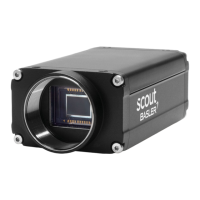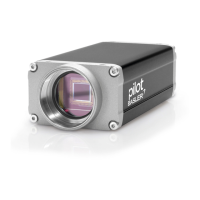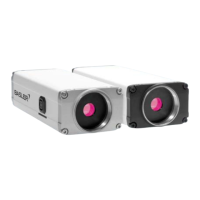AW00089317000 Color Creation and Enhancement
Basler ace GigE 173
8.4 Color Enhancement Features
8.4.1 White Balance
On all color cameras equipped with a Bayer pattern filter (i.e., all camera models except the
acA750-30gc) the pixel values output from the sensor reside in the RGB color space.
On the acA750-30gc camera model, the pixel values output from the sensor are first converted to
YUV and are then converted to the RGB color space.
The white balancing feature implemented in the camera acts on the colors when they are in the
RGB color space, so the feature lets you perform red, green, and blue adjustments. The purpose
of the feature is to let you adjust the balance of red, green, and blue such that white objects in the
camera’s field of view appear white in the acquired images.
Setting the White Balance
With the white balancing scheme used on these cameras, the red intensity, green intensity, and blue
intensity can be individually adjusted. For each color, a Balance Ratio Abs parameter is used to set
If color binning is enabled for the acA1920-25gc or acA2500-14gc, white
balancing will be applied after color binning was performed. For more information
about color binning, see Section 10.9.2 on page 259.
This section (Section 8.4.1) describes how a color camera’s white balance can be
adjusted "manually", i.e., by setting the value of the Balance Ratio Abs parameters
for red, green, and blue.
The camera also has a White Balance Auto function that can automatically adjust
the white balance. Manual adjustment of the Balance Ratio Abs parameters
for red, green, and blue will only work, if the Balance White Auto function is
disabled.
For more information about
auto functions in general, see Section 10.13 on page 276.
the Balance White Auto function, see Section 10.13.8 on page 290.
When you are using matrix color transformation and you set the Light Source
Selector parameter to match your light source characteristics, the camera will
automatically make adjustments to the white balance settings so that they are best
suited for the light source you selected.
For more information about matrix color transformation, see Section 8.4.3 on
page 177 and Section 8.4.4 on page 182.

